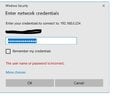- Thread Author
- #1
I am the admin on both systems. I have logged into both using my MSFT account. The Pro system is on the same Workgroup (MSHOME) as the Home system. Home is Wired, Pro has been wired and also trying Wifi (no difference). I noticed the Pro system does not show under the Explorer Network section (have seen this before, never really matters). Running a LanScope scan I see the PC's (and a few others) tagged by IP address and their Netbios (computer name) assigned to MSHOME.
Yet trying to map a drive from the Home to the Pro (using Netbios or IP address), I am greeted with the ENTER NETWORK CREDENTIAL screen. I enter my MSFT account info (really slowly to make sure its right) and I get "username or password" incorrect. I've tried a bunch of things, read "advice" and watched youtube videos and made no progress. I'm convinced this is something to do with Windows Pro or the configuration of the system.
I'm baffled... looking for some shared experiences. BTW this Pro machine has already mapped drives on other Home Machines and my Synology NAS.
Yet trying to map a drive from the Home to the Pro (using Netbios or IP address), I am greeted with the ENTER NETWORK CREDENTIAL screen. I enter my MSFT account info (really slowly to make sure its right) and I get "username or password" incorrect. I've tried a bunch of things, read "advice" and watched youtube videos and made no progress. I'm convinced this is something to do with Windows Pro or the configuration of the system.
I'm baffled... looking for some shared experiences. BTW this Pro machine has already mapped drives on other Home Machines and my Synology NAS.

